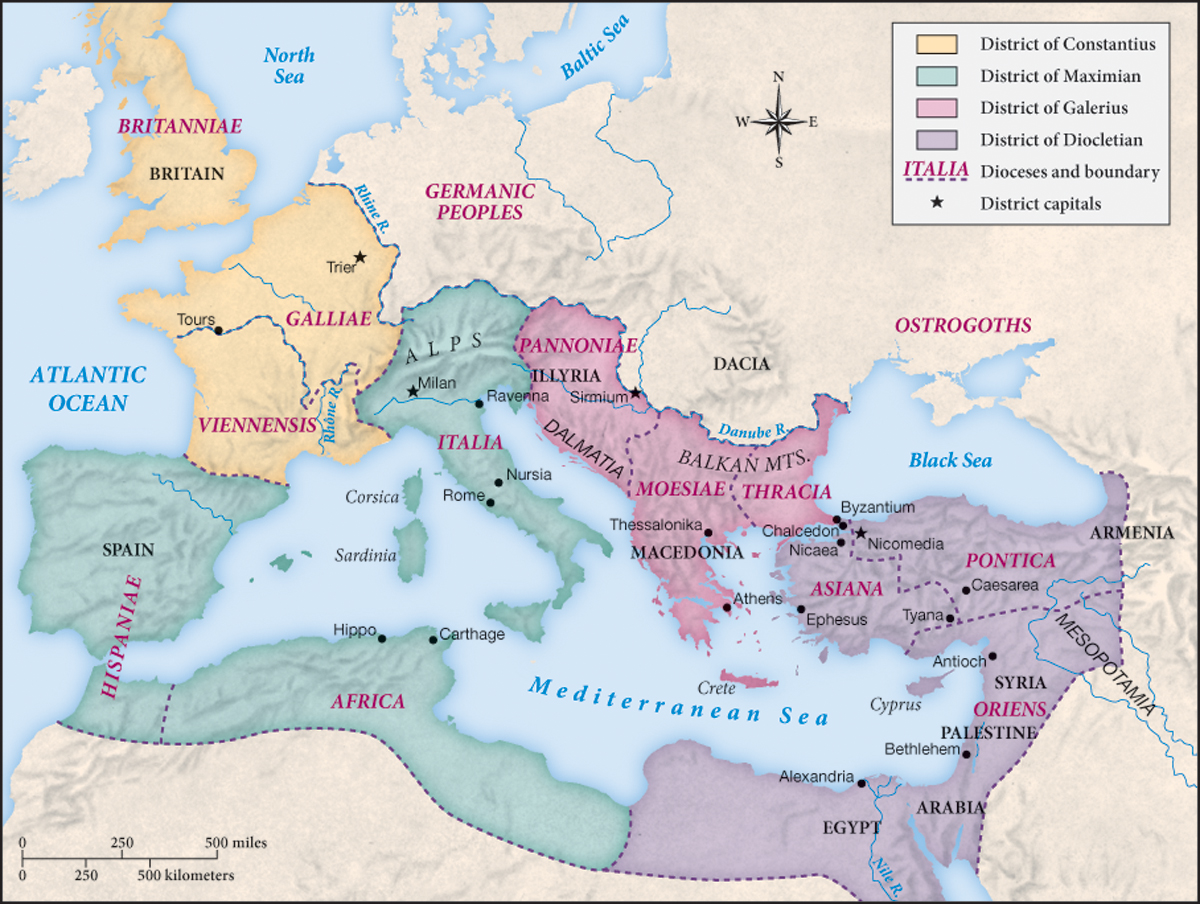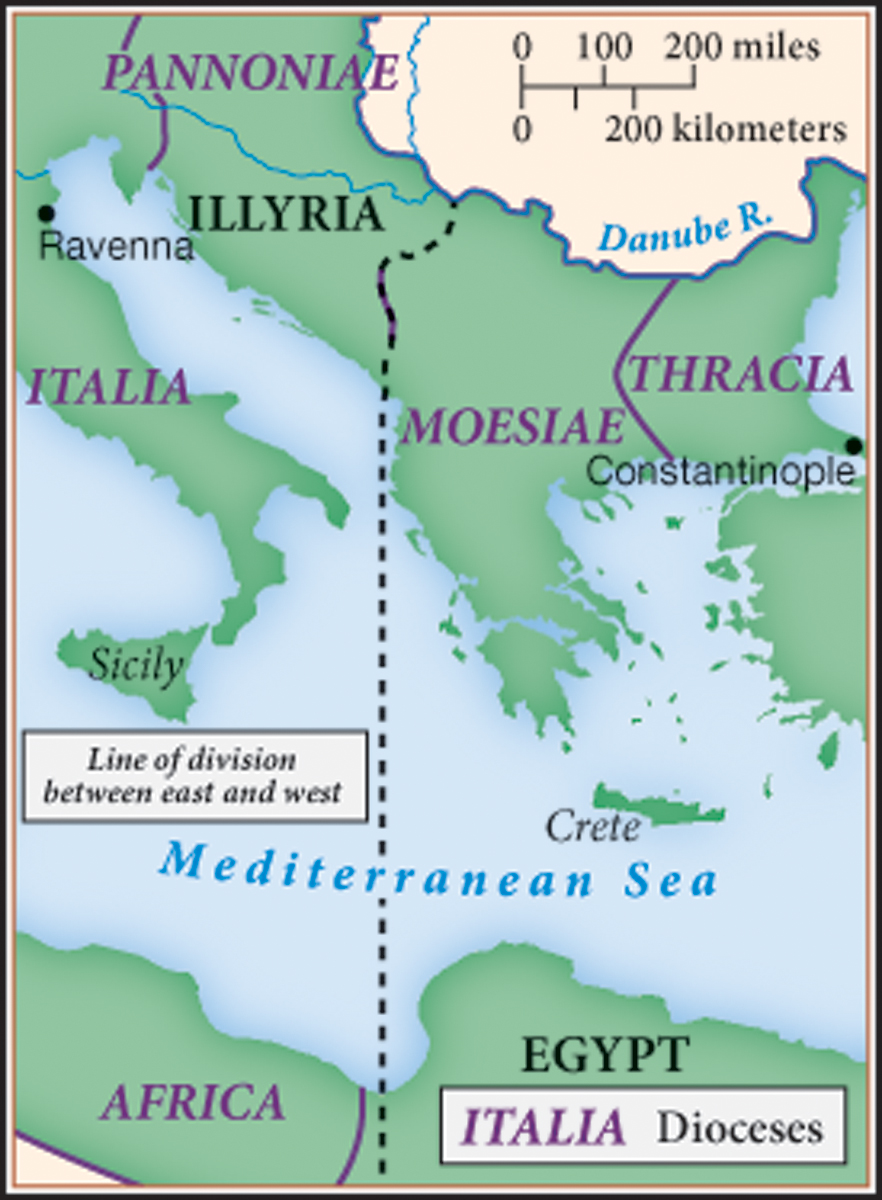The Political Transformation and Division of the Roman Empire
Printed Page 212
Important EventsThe Political Transformation and Division of the Roman Empire
No one could have predicted Diocletian’s rise to power: he began life as an uneducated peasant in the Balkans, but his leadership, courage, and intelligence propelled him through the ranks until the army made him emperor in 284. He ended a half a century of civil war by imposing the most autocratic system of rule in Roman history.
Historians refer to Roman rule from Diocletian onward as the dominate because he took the title dominus (“lord” or “master”)—what slaves called their owners. The emperors of the dominate continued to refer to their government as the Roman Republic, but in truth they ruled autocratically. This new system eliminated the principate’s ideal of the princeps (“first man”) as the social equal of the senators. The emperors of the dominate now recognized no equals. The offices of senator, consul, and other traditional positions continued, but only as posts of honor. These officials had the responsibility to pay for public services, especially chariot races and festivals, but no power to govern. Imperial administrators were increasingly chosen from lower ranks of society according to their competence and their loyalty to the emperor.
The dominate’s emperors took ideas for emphasizing their superiority from the Sasanids in Persia, whose empire (224–651) they recognized as equal to their own in power and whose king and queen they addressed as “our brother” and “our sister.” The Roman Empire’s masters broadcast their majesty by surrounding themselves with courtiers and ceremony, presiding from a raised platform, and sparkling in jeweled crowns, robes, and shoes. Constantine took from Persia the tradition that emperors set themselves apart by wearing a diadem, a purple gem-studded headband. In another echo of Persian monarchy, a series of veils separated the palace’s waiting rooms from the interior room where the emperor listened to people’s pleas for help or justice. Officials marked their rank by wearing special shoes and belts and claiming grandiose titles such as “Most Perfect.”
The dominate’s emperors also asserted their supreme power through laws and punishments. They alone made law. To impose order, they raised punishments to brutal levels. New punishments included Constantine’s order that the “greedy hands” of officials who took bribes “shall be cut off by the sword.” The guardians of a young girl who allowed a lover to seduce her were executed by having molten lead poured into their mouths. Penalties grew ever harsher for the majority of the population, legally designated as “humbler people,” who were punished more severely than the “better people” for comparable offenses. In this way, the dominate strengthened the divisions between ordinary people and the rich.
Diocletian appointed three “partners” (a co-emperor, Maximian, and two assistant emperors, Constantius and Galerius, who were the designated successors) to join him in ruling the empire in a tetrarchy (“rule by four”). Each ruler controlled one of four districts. Diocletian served as supreme ruler and was supposed to receive the loyalty of the others. He also created smaller administrative units, called dioceses, under separate governors, who reported to the four emperors’ assistants, the praetorian prefects (Map 7.1). This system was Diocletian’s attempt to put imperial government into closer contact with the empire’s frontier regions, where the dangers of invasion and rebellious troops loomed.

Diocletian’s reforms ended Rome’s thousand years as the empire’s most important city. Diocletian did not even visit Rome until 303, nearly twenty years after becoming emperor. Italy became just another section of the empire, now subject to the same taxation as everywhere else.
Diocletian resigned in 305 for unknown reasons, after which rivals for power abandoned the tetrarchy and fought a civil war until 324, when Constantine finally won. At the end of his reign in 337, Constantine designated his three sons to rule as co-emperors. Failing to cooperate, they waged war against one another.

Constantine’s warring sons unofficially split the empire on a north–south line along the Balkan peninsula, a division that Theodosius made permanent in 395. In the long run, the empire’s halves would be governed largely as separate territories despite the emperors’ insistence that the empire remained one state.
Each half had its own capital city. Constantinople (“Constantine’s City”)—formerly the ancient city of Byzantium (today Istanbul, Turkey)—was the eastern capital. Constantine made it his capital, a “new Rome,” because of its strategic military and commercial location: it lay at the mouth of the Black Sea guarding principal routes for trade and troop movements. To recall the glory of Rome, Constantine constructed a forum, an imperial palace, a hippodrome for chariot races, and monumental statues of the traditional gods in his refounded city. Constantinople grew to be the most important city in the Roman Empire.
Honorius, Theodosius’s son and successor in the west, wanted a headquarters that was easy to defend. In 404, he chose the port of Ravenna, a commercial center on Italy’s northeastern coast housing a naval base. Marshes and walls protected Ravenna by land, while its harbor kept it from being starved out in a siege. Though the emperors enhanced Ravenna with churches covered in multicolored mosaics, it never rivaled Constantinople in size or splendor.